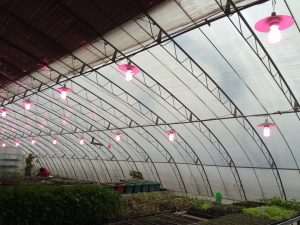Driving across IN now, it is not uncommon to see many recently built high tunnels standing along the roadsides. These structures have become an important tool for farmers to extend production seasons of vegetable and fruit crops. Compared with traditional greenhouses, high tunnel demand much less energy as they are heated by solar energy and ventilated through natural air circulation.
Similar to high tunnels, Chinese-style solar greenhouse is an important tool for season extension in specialty crop production in China. The structures are facing south, featured by supporting north walls (Figure 1 and 2). The north walls are essential in maintaining temperatures inside the structure. They are made up with materials having good insulation properties and with a thickness more than 30 inches. The south sides are arch-shaped, supported by steels and covered with polyethylene or polyvinyl chloride films. From north to south, the structures span 26-46 feet. A short roof is installed on top of the north wall with the peak heights about 12-18 feet. On the bottom part of the south side, plastic films can be rolled up and down for ventilation. In winter, the plastic films are covered with insulation pads that are made up with straws to conserve heat at night. In summer, external shading systems are added to reduce temperatures. An entrance room is often attached with the main structure.
The innovative structures play a vital role in winter vegetable production in north China (latitude 32°N to 43°N; latitude of Indiana is roughly from 37°N to 41°N). The most popular vegetables grown in the solar greenhouses include cucumbers, melons, tomatoes, eggplants, peppers, strawberries and leafy vegetables. Cucurbits and solanaceous crops are grown into two seasons: a fall-winter production from late August to January, and a winter-spring production from January to June. Strawberries are planted in late August or September and end in late spring in the next year. Leafy vegetables that have short growing seasons are grown for multiple seasons in a year.
The lowest internal temperature inside the structure is seldom below 40°F even though outside greenhouse temperature is in the range of single digitals. In sunny days around noon, temperature can stay above 60°F when outside temperature is around 0 °F. Microenvironments inside the structures are featured by high humidity and extreme temperature fluctuations. In winter, when there is little ventilation, internal Relative Humidity can reach over 90% that make disease management challengeable. Another disadvantage of the Chinese-style solar greenhouses is low-light and uneven light distribution. To address the challenge, incorporating modern LED light technology in the structures is currently being tested in several places in China (Figure 3).



